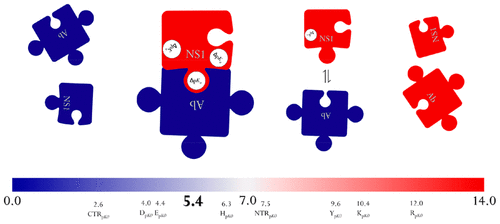当前位置:
X-MOL 学术
›
J. Chem. Inf. Model.
›
论文详情
Our official English website, www.x-mol.net, welcomes your
feedback! (Note: you will need to create a separate account there.)
Identification of Electrostatic Epitopes in Flavivirus by Computer Simulations: The PROCEEDpKa Method.
Journal of Chemical Information and Modeling ( IF 5.6 ) Pub Date : 2020-01-03 , DOI: 10.1021/acs.jcim.9b00895 Sergio A Poveda-Cuevas 1, 2, 3 , Catherine Etchebest 3, 4, 5, 6 , Fernando L Barroso da Silva 1, 2, 3, 7
Journal of Chemical Information and Modeling ( IF 5.6 ) Pub Date : 2020-01-03 , DOI: 10.1021/acs.jcim.9b00895 Sergio A Poveda-Cuevas 1, 2, 3 , Catherine Etchebest 3, 4, 5, 6 , Fernando L Barroso da Silva 1, 2, 3, 7
Affiliation

|
Viruses are enthusiastically studied due to the great impact that these organisms can have on human health. Computational approaches can contribute offering tools that can shed light on important molecular mechanisms that help to design new diagnostic procedures. Several cellular processes between the immune-host system and the pathogenic organism are dependent on specific intermolecular interactions. In this study, we evaluated theoretical approaches to understand some properties of the antigen-antibody interactions considering the titratable properties of all ionizable residues of the nonstructural viral protein 1 (NS1) of the West Nile virus (WNV) and the Zika virus (ZIKV). Constant-pH Monte Carlo simulations were performed to estimate electrostatic properties such as the pKa shifts (ΔpKa). We proposed an alternative criterion for the discrimination of antigenic residues based on ΔpKas. Our outcomes were analyzed by an evaluation of the sensitivity and specificity through a receiver operating characteristic (ROC). As a starting point, we used the known crystallographic structure for the complex of NS1WNV(176-352) and the specific antibody 22NS1 (PDB ID 4OII ) to differentiate the residues belonging to that interface. With an optimal threshold for the absolute value of the pKa shifts, we found that is possible to predict antigenic epitopes reproducing the interfaces as defined by the X-ray structure. After this validation, we evaluated theoretical predictions based on protein-protein (PP) complexation simulations. From them, we observe amino acids with an antigenic potential and defined the optimum threshold that was applied for two strains of ZIKV (i.e., Uganda and Brazil). Several ionizable residues with antigenic capacity were identified. This is favorably related to some studies that show the high immunogenicity of secreted NS1. This approach opens up an important discussion about what are termed here "electrostatic epitopes" and how they work as an important reference in the paratope-epitope interaction for viral systems.
中文翻译:

通过计算机模拟鉴定黄病毒中的静电表位:PROCEEDpKa方法。
由于这些生物会对人类健康产生巨大影响,因此人们对病毒进行了热情的研究。计算方法可以为提供工具提供帮助,这些工具可以阐明有助于设计新诊断程序的重要分子机制。免疫宿主系统和病原生物之间的几种细胞过程取决于特定的分子间相互作用。在这项研究中,我们考虑了西尼罗河病毒(WNV)和寨卡病毒(ZIKV)的非结构性病毒蛋白1(NS1)的所有可电离残基的滴定特性,从而评估了了解抗原-抗体相互作用的某些特性的理论方法。 。进行恒定pH值的蒙特卡洛模拟以估算静电性能,例如pKa位移(ΔpKa)。我们提出了一种基于ΔpKas的抗原残基判别的替代标准。我们的结果通过接受者操作特征(ROC)对敏感性和特异性的评估进行了分析。首先,我们使用NS1WNV(176-352)和特异性抗体22NS1(PDB ID 4OII)的复合物的已知晶体结构来区分属于该界面的残基。利用pKa位移绝对值的最佳阈值,我们发现可以预测复制X射线结构定义的界面的抗原表位。验证之后,我们根据蛋白质-蛋白质(PP)络合模拟评估了理论预测。从他们,我们观察到具有抗原潜力的氨基酸,并定义了适用于两种ZIKV菌株(即乌干达和巴西)的最佳阈值。鉴定了具有抗原能力的几个可电离的残基。这与某些显示分泌的NS1具有高度免疫原性的研究密切相关。这种方法开启了一个重要的讨论,即所谓的“静电表位”以及它们如何在病毒系统的对位-表位相互作用中作为重要参考。
更新日期:2020-01-04
中文翻译:

通过计算机模拟鉴定黄病毒中的静电表位:PROCEEDpKa方法。
由于这些生物会对人类健康产生巨大影响,因此人们对病毒进行了热情的研究。计算方法可以为提供工具提供帮助,这些工具可以阐明有助于设计新诊断程序的重要分子机制。免疫宿主系统和病原生物之间的几种细胞过程取决于特定的分子间相互作用。在这项研究中,我们考虑了西尼罗河病毒(WNV)和寨卡病毒(ZIKV)的非结构性病毒蛋白1(NS1)的所有可电离残基的滴定特性,从而评估了了解抗原-抗体相互作用的某些特性的理论方法。 。进行恒定pH值的蒙特卡洛模拟以估算静电性能,例如pKa位移(ΔpKa)。我们提出了一种基于ΔpKas的抗原残基判别的替代标准。我们的结果通过接受者操作特征(ROC)对敏感性和特异性的评估进行了分析。首先,我们使用NS1WNV(176-352)和特异性抗体22NS1(PDB ID 4OII)的复合物的已知晶体结构来区分属于该界面的残基。利用pKa位移绝对值的最佳阈值,我们发现可以预测复制X射线结构定义的界面的抗原表位。验证之后,我们根据蛋白质-蛋白质(PP)络合模拟评估了理论预测。从他们,我们观察到具有抗原潜力的氨基酸,并定义了适用于两种ZIKV菌株(即乌干达和巴西)的最佳阈值。鉴定了具有抗原能力的几个可电离的残基。这与某些显示分泌的NS1具有高度免疫原性的研究密切相关。这种方法开启了一个重要的讨论,即所谓的“静电表位”以及它们如何在病毒系统的对位-表位相互作用中作为重要参考。











































 京公网安备 11010802027423号
京公网安备 11010802027423号